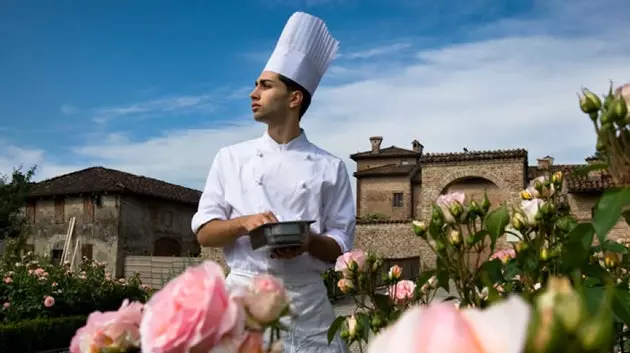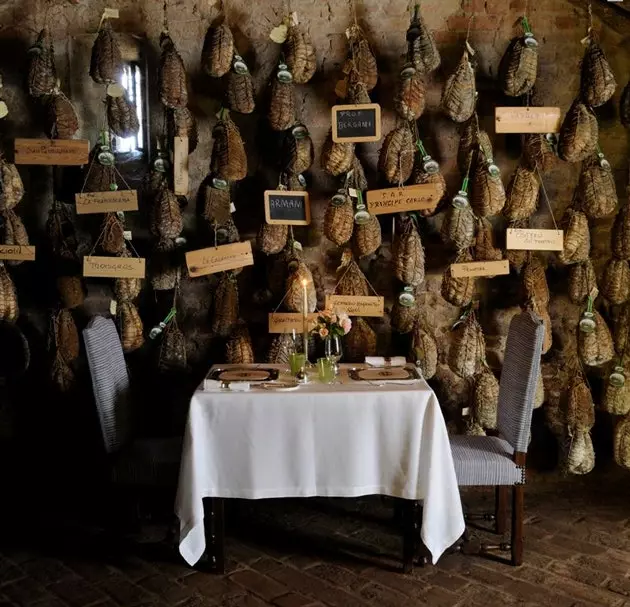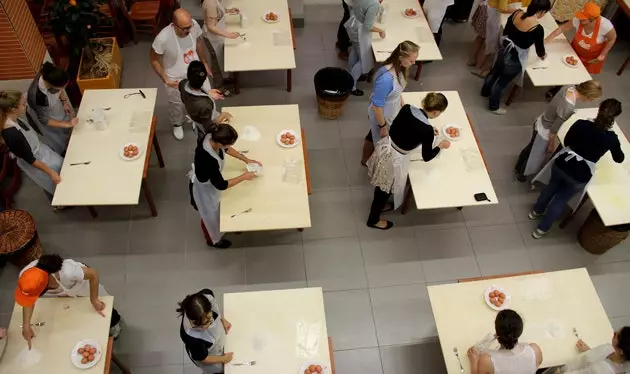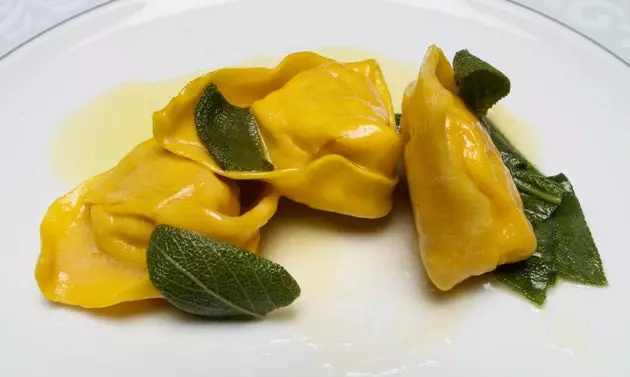
Antica Corte Pallavicina, a culinary 'palace' in Polesine Parmense.
PARMA
Surely you will not meet many tourists in the one day it was the capital of the historic Duchy of Parma, so after calmly visiting the Duomo and the Battistero Tower you will still have time to find a salumeria where you can buy the most typical products of the province.
The first thing you have to keep in mind is that Parma ham (prosciutto di Parma) is not like Jabugo or Iberian, so don't try to compare them or create a scale of values. this ham it is sweet, delicate, rosy and has become a Protected Designation of Origin (DPO) product thanks to the area's climate and the efforts of the Consorzio del Prosciutto di Parma to maintain traditional production techniques (without any type of additive other than salt or own lard). Get yourself a piece that looks the fire printed ducal crown (guarantee of authenticity) at the Prosciutteria Noi da Parma.
Another more unknown specialty from the province of Parma is the C **ulatello di Zibello: pear-shaped (it is cured inside the pig's bladder) ** and a much more refined flavor than that of the prosciutto. Discover its conscientious preparation in the cooking classes at Antica Corte Pallavicina. The best thing, that in addition to being able to sleep, after the healing process, they will send the piece directly to your home so you can check how much Italian chef you have managed to become.

In the cellars of Antica Corte Pallavicina each Culatello di Zibello is cured.
MODENA
In the photos of the Museo Casa Enzo Ferrari (a building in the shape of the hood of a car) you can see how back in the 1940s the asphalt of the city of Modena vibrated as the races that were held in its streets passed by. But the so-called Terra di Motori has other types of much more succulent attractions (without, of course, forgetting the Ghirlandina of its cathedral):
As much as you are from the village, surely you have never heard of a hoof stuffed with the pork itself and other spices that is cooked and eaten in slices. Well, this delicatessen that is usually served in the north of Italy on New Year's Eve together with lentils is called Zampone di Modena. You can get one at the Salumeria Giusti or, while you're there, eat it at one of the five tables that the place has in the back by way of _trattotori_a di la mama [I take back what I said, better call beforehand to try to make a reservation, since since the Italian chef Mario Batali commented that it is one of his favorite restaurants in Italy, finding space is very complicated].
BOLOGNA
They say at the Barilla Academy that at the beginning of the 20th century Bologna bologna was banned in the United States and that the Italian immigrants had to see and want to get across the border with this product of lean meat and intense smell. reviled for years, this delicacy is being revisited by renowned chefs and is found again in the most select restaurants . This recovered fame has had a lot to do with its artisanal preparation where the meat is mixed with the pig's stomach and the butter from the animal's neck. For example, the antipasti at the refined Ristorante Diana, near Piazza dell'Otto Agosto, features an elaborate Affettato misto con mortadella "Due torri" Alcisa.
If you want to learn how traditional pasta is made, including some tortellini stuffed with mortadella and pork loin, sign up for one of the intensive cooking classes of the Vecchia Scuola Bolognese. It will be the best spent 95 euros of your trip, since from then on you will never again accompany the Ragù alla Bolognese with spaghetti or sprinkle it with Parmesan cheese (this last point will depend on how purist your teacher is).

Cooking classes at the Vecchia Scuola Bolognese.
FERRARA
The fact that the Roman Via Emilia, which passes through Parma, Modena and Bologna, does not pass through Ferrara caused the city to fall into oblivion for centuries, but today, far from being an inconvenience, it has become its greatest attraction. So much so that the Italians themselves, when looking for an authentic piece of their country, decide to go for a bike ride (they say there are more bikes than people in Ferrara) through its 15th-century cobbled streets . They also boast of traditional products that practically date from these dates.
Apparently, when the Salamina da sugo, a kind of soft salami typical of the province of Ferrara, presided over the ducal tables (legend assures that Lucrezia Borgia was the one who made it fashionable at her lively banquets) its intense smell of cloves and cinnamon flooded everything. Today, there are companies that have decided to recover this old recipe, but the usual thing is that it only has pepper and nutmeg. Yes indeed, what is never lacking in its preparation is wine, sorry, a lot of wine. If the weather is good, there is no better place to eat the typical cured meats than in the shade of the cherry trees in the garden of the Schifanoia Palace, at the Ristorante Schifanoia . One piece of advice, don't skip a visit to Il Ristorantino di Colomba, where you will kill two birds with one stone, since in addition they are experts in preparing one of the most traditional and delicious dishes of the region: cappellacci di zucca (fresh pasta similar to ravioli stuffed with pumpkin) .

Cappellacci di zucca, fresh pasta from Ferrara similar to ravioli stuffed with pumpkin.
